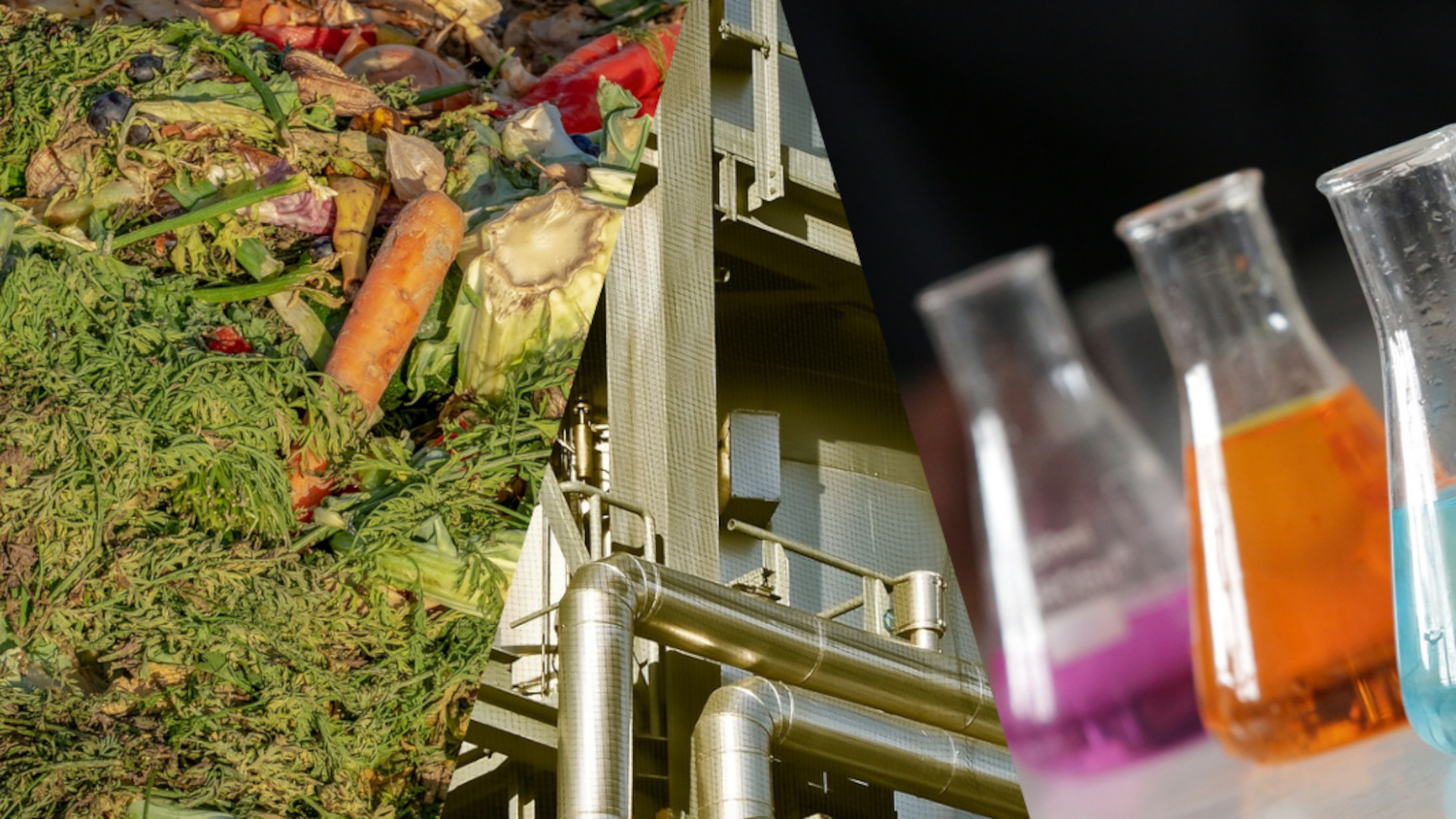Amidst the current global crisis, we are working hard on keeping up the pace of last year. We are all bound to our home office and will continue working from here. Fortunately, our CTO Gerald Bauer lives right around the corner from the laboratory and can still synthesise samples and larger batches.
To keep spirits up, we meet daily in our virtual coffee break to just chat and exchange whatever is on our minds. It’s not the same easy flow of information as we are used to before the crisis, but better than nothing.
Anyways, we had two very positive news in the last quarter:
Daniel made it into Forbes 30 und 30 2020 list, pretty much 3 years after founding novoMOF AG. It’s awesome to be recognised by such influential media!

Moreover, we welcomed Claudio Reale to our team! Before novoMOF, Claudio has worked in the production of different chemical and pharmaceutical companies. He supports Gerald in the laboratory and in the production of MOFs.
Stay home, stay safe! We wish you and your loved ones all the best!
From our blog
New articles of the last quarter

Nano-reactor vessels open new fields of catalysis
Porous materials can alter the yield of homogeneous catalysis towards desired end-products.
New materials for high efficiency oxygen concentrators
Current oxygen concentrators mainly remove the unnecessary nitrogen. MOFs that capture the valuable, less abundant oxygen could improve efficiency and save lives.
Picking a single grain – purification of nobel gases
The limited abundance of nobel gases and the current purification method result in high costs. Adsorption instead of cryogenic distillation could be an energy-efficient option.
Interesting publications
We have categorised the publications and news in the following sections (click to skip to the section):
Publications related to Carbon capture, reduction, storage and alternative energy
High-Performance CO2-Selective Hybrid Membranes by Exploiting MOF-Breathing Effects
Conventional CO2 separation in the petrochemical industry via cryogenic distillation or amine-based absorber–stripper units is energy-intensive and environmentally unfriendly. Membrane-based gas separation technology, in contrast, has contributed significantly to the development of energy-efficient systems for processes such as natural gas purification. The implementation of commercial polymeric membranes in gas separation processes is restricted by their permeability–selectivity trade-off and by their insufficient thermal and chemical stability. Herein, we present the fabrication of a Matrimid-based membrane loaded with a breathing metal–organic framework (MOF) (NH2-MIL-53(Al)) which is capable of separating binary CO2/CH4 gas mixtures with high selectivities without sacrificing much of its CO2 permeabilities. This approach provides significant advancement toward the design of selective MMMs with enhanced thermal and chemical stabilities which could also be applicable for other potential applications, such as separation of hydrocarbons (olefin/paraffin or isomers), pervaporation, and solvent-resistant nanofiltration.
Three metal-organic framework isomers of different pore sizes for selective CO2 adsorption and isomerization studies
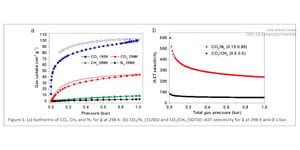 Metal-organic frameworks (MOFs) or porous coordination polymers (PCPs) with tunable pore size, shape and functionality have showed excellent prospects in many applications, such as carbon capture. Molecular sieving can usually enable very high CO2 adsorption selectivity but has rarely been achieved, because it is difficult to precisely control the pore size in the range of 3-4 Å. We report here three MOF isomers. 1 contains 2-fold interpenetrated networks (topology of pcu) and 1D ultra-micropores, and showed highly selective adsorption of CO2 over N2 and CH4, which is mainly ascribed to the molecular sieving effect of the framework. 2 contains a pcu network of 3D interconnected micropores, and 3 contains a kag network of much larger pores of 15 Å.
Metal-organic frameworks (MOFs) or porous coordination polymers (PCPs) with tunable pore size, shape and functionality have showed excellent prospects in many applications, such as carbon capture. Molecular sieving can usually enable very high CO2 adsorption selectivity but has rarely been achieved, because it is difficult to precisely control the pore size in the range of 3-4 Å. We report here three MOF isomers. 1 contains 2-fold interpenetrated networks (topology of pcu) and 1D ultra-micropores, and showed highly selective adsorption of CO2 over N2 and CH4, which is mainly ascribed to the molecular sieving effect of the framework. 2 contains a pcu network of 3D interconnected micropores, and 3 contains a kag network of much larger pores of 15 Å.
Design of metal-organic framework-based photocatalysts for hydrogen generation
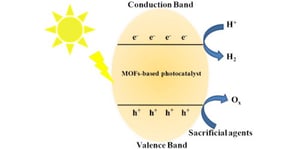 Metal-organic framework (MOF) materials are suitable for photocatalytic hydrogen production reactions due to their tunable structure, modifiable pores and a large number of active sites. Recently, many studies have enhanced the light absorption capacity of MOF and promoted the separation of photogenerated charges by altering the structure of MOF materials or preparing MOF composites/derived materials. Besides, their hydrogen production efficiency and mechanism were analyzed in details. This review summarizes the photocatalytic hydrogen production applications of MOF-based materials based on lights with different wavelengths.
Metal-organic framework (MOF) materials are suitable for photocatalytic hydrogen production reactions due to their tunable structure, modifiable pores and a large number of active sites. Recently, many studies have enhanced the light absorption capacity of MOF and promoted the separation of photogenerated charges by altering the structure of MOF materials or preparing MOF composites/derived materials. Besides, their hydrogen production efficiency and mechanism were analyzed in details. This review summarizes the photocatalytic hydrogen production applications of MOF-based materials based on lights with different wavelengths.
Supercapacitors/semiconductors and batteries/photovoltaic based on MOFs
Electrochromic-Supercapacitor Based on MOF Derived Hierarchical-Porous NiO Film
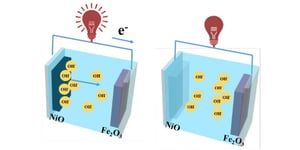 Nickel oxide (NiO) is a promising candidate for future electrochromic-supercapacitors due to its pronounced electrical properties and low cost. Unfortunately, the weak interaction between NiO film and conductive substrate results in poor cycle stability. In addition, the long color-switching time and low capacitance by the small lattice spacing in dense NiO impede its practical applications seriously. Herein, a hierarchical porous NiO film/ITO glass bifunctional electrode has been prepared via the solvothermal and subsequent calcination process of MOF-74 growing in-situ on ITO, which shows outstanding cycle reversibility, excellent capacitance, high coloration efficiency and short color-switching time. Because of the strong binding force between NiO film and substrate, and large surface areas with a hierarchical porous structure which are beneficial to the ion transport, the NiO film demonstrates perfect capacitive and electrochromic properties. As a bifunctional electrode, the NiO film shows the specific capacitance of 2.08 F cm-2 at 1 mA cm-2, large optical modulation of 41.08% and more than 90% of optical modulation retention after 10000 cycles. Furthermore, we assembled a bifunctional device whose energy condition can be roughly estimated according to the color state of the device. This finding can provide us with a new application of MOFs in the dual device of electrochromic-supercapacitor.
Nickel oxide (NiO) is a promising candidate for future electrochromic-supercapacitors due to its pronounced electrical properties and low cost. Unfortunately, the weak interaction between NiO film and conductive substrate results in poor cycle stability. In addition, the long color-switching time and low capacitance by the small lattice spacing in dense NiO impede its practical applications seriously. Herein, a hierarchical porous NiO film/ITO glass bifunctional electrode has been prepared via the solvothermal and subsequent calcination process of MOF-74 growing in-situ on ITO, which shows outstanding cycle reversibility, excellent capacitance, high coloration efficiency and short color-switching time. Because of the strong binding force between NiO film and substrate, and large surface areas with a hierarchical porous structure which are beneficial to the ion transport, the NiO film demonstrates perfect capacitive and electrochromic properties. As a bifunctional electrode, the NiO film shows the specific capacitance of 2.08 F cm-2 at 1 mA cm-2, large optical modulation of 41.08% and more than 90% of optical modulation retention after 10000 cycles. Furthermore, we assembled a bifunctional device whose energy condition can be roughly estimated according to the color state of the device. This finding can provide us with a new application of MOFs in the dual device of electrochromic-supercapacitor.
MOF-derived lithiophilic CuO nanorod arrays for stable lithium metal anode
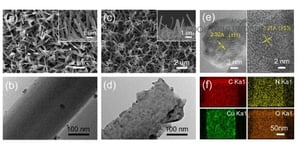 Lithium (Li) metal is regarded as the most promising anode material for next-generation high-energy-density rechargeable batteries. However, the uncontrolled growth of Li dendrites and its infinite volume expansion decreases the coulombic efficiency and causes safety concerns. One of the best strategies to solve these problems is engineering a nanostructured interface on the current collector. Thus, in the present paper, to regulate Li nucleation and suppress the growth of Li dendrites, Metal-organic-framework (MOF)-derived CuO nanorod arrays with lithiophilic groups were synthesized as a Cu foil current collector (CuO NAs/CF). The CuO nanorod arrays with the N-containing group in the CuO NAs/CF not only acted as lithiophilic active sites to reduce the nucleation barrier to Li deposition, but also decreased the current density and homogenized the Li ion flux distribution. The CuO NAs/CF electrode showed a high coulombic efficiency of 98% for more than 180 cycles at 1 mA cm–2 as well as excellent cycling stability with a low overpotential of 30 mV for 600 h in symmetric cells. Based on the Li-CuO NAs/CF composite anode, full cells with a LiFePO4 cathode showed improved cycling stability, small polarization, and flat voltage curves compared with cells using a planar Cu current collector. This work provides a new strategy for designing MOF-derived materials for stable, dendrite-free lithium metal anodes.
Lithium (Li) metal is regarded as the most promising anode material for next-generation high-energy-density rechargeable batteries. However, the uncontrolled growth of Li dendrites and its infinite volume expansion decreases the coulombic efficiency and causes safety concerns. One of the best strategies to solve these problems is engineering a nanostructured interface on the current collector. Thus, in the present paper, to regulate Li nucleation and suppress the growth of Li dendrites, Metal-organic-framework (MOF)-derived CuO nanorod arrays with lithiophilic groups were synthesized as a Cu foil current collector (CuO NAs/CF). The CuO nanorod arrays with the N-containing group in the CuO NAs/CF not only acted as lithiophilic active sites to reduce the nucleation barrier to Li deposition, but also decreased the current density and homogenized the Li ion flux distribution. The CuO NAs/CF electrode showed a high coulombic efficiency of 98% for more than 180 cycles at 1 mA cm–2 as well as excellent cycling stability with a low overpotential of 30 mV for 600 h in symmetric cells. Based on the Li-CuO NAs/CF composite anode, full cells with a LiFePO4 cathode showed improved cycling stability, small polarization, and flat voltage curves compared with cells using a planar Cu current collector. This work provides a new strategy for designing MOF-derived materials for stable, dendrite-free lithium metal anodes.
Novel Quaternary Ammonium-Functionalized Covalent Organic Frameworks/Poly(2,6-dimethyl-1,4-phenylene oxide) Hybrid Anion Exchange Membranes with Enhanced Ion Conductivity and Stability
Here we report a new hybrid anion exchange membrane with enhanced hydroxide conductivity and excellent chemical and dimensional stability by incorporating quaternary ammonium (QA)-functionalized covalent organic framework into brominated poly(2,6-dimethyl-1,4-phenylene oxide) (BPPO). N,N,N′,N′ -Tetramethyl-1,6-hexanediamine (TMHDA) was impregnated into the pores of COF-LZU1 via a vacuum-assisted method, followed by reacting with allyl bromide. The generated QA groups were immobilized within the highly ordered pores of COF-LZU1 via in situ polymerization, forming long-range ordered multiple ion channels. The obtained QA@COF-LZU1 was then mixed with QAPPO to construct a hybrid anion exchange membrane for anion exchange membrane fuel cells (AEMFCs). The hydroxide conductivity of QA@COF-LZU1/PPO hybrid membrane increased up to 168.00 mS cm–1 at 80 °C, about 77% higher than that of pristine membrane. In addition, alkaline stability and thermal stability of the hybrid membranes were obviously enhanced. The excellent performance and the outstanding chemical stability render the COF hybrid membrane a good candidate for the application in AEMFCs.
Molecular understanding of charge storage and charging dynamics in supercapacitors with MOF electrodes and ionic liquid electrolytes
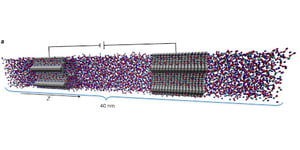 We performed constant-potential molecular dynamics simulations to analyse the double-layer structure and capacitive performance of supercapacitors composed of conductive metal–organic framework (MOF) electrodes and ionic liquids. The molecular modelling clarifies how ions transport and reside inside polarized porous MOFs, and then predicts the corresponding potential-dependent capacitance in characteristic shapes. The transmission line model was adopted to characterize the charging dynamics, which further allowed evaluation of the capacitive performance of this class of supercapacitors at the macroscale from the simulation-obtained data at the nanoscale. These ‘computational microscopy’ results were supported by macroscopic electrochemical measurements. Such a combined nanoscale-to-macroscale investigation demonstrates the potential of MOF supercapacitors for achieving unprecedentedly high volumetric energy and power densities. It gives molecular insights into preferred structures of MOFs for accomplishing consistent performance with optimal energy–power balance, providing a blueprint for future characterization and design of these new supercapacitor systems.
We performed constant-potential molecular dynamics simulations to analyse the double-layer structure and capacitive performance of supercapacitors composed of conductive metal–organic framework (MOF) electrodes and ionic liquids. The molecular modelling clarifies how ions transport and reside inside polarized porous MOFs, and then predicts the corresponding potential-dependent capacitance in characteristic shapes. The transmission line model was adopted to characterize the charging dynamics, which further allowed evaluation of the capacitive performance of this class of supercapacitors at the macroscale from the simulation-obtained data at the nanoscale. These ‘computational microscopy’ results were supported by macroscopic electrochemical measurements. Such a combined nanoscale-to-macroscale investigation demonstrates the potential of MOF supercapacitors for achieving unprecedentedly high volumetric energy and power densities. It gives molecular insights into preferred structures of MOFs for accomplishing consistent performance with optimal energy–power balance, providing a blueprint for future characterization and design of these new supercapacitor systems.
Efficient and tunable one-dimensional charge transport in layered lanthanide metal–organic frameworks
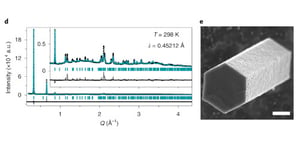 The emergence of electrically conductive metal–organic frameworks (MOFs) has led to applications in chemical sensing and electrical energy storage, among others. The most conductive MOFs are made from organic ligands and square-planar transition metal ions connected into two-dimensional (2D) sheets stacked on top of each other. Their electrical properties are thought to depend critically on the covalency of the metal–ligand bond, and less importance is given to out-of-plane charge transport. Here, we report a series of lanthanide-based MOFs that allow fine tuning of the sheet stacking. In these materials, the Ln3+ ions lie between the planes of the ligands, thus connecting organic layers into a 3D framework through lanthanide–oxygen chains. Here, efficient charge transport is found to occur primarily perpendicular to the 2D sheets. These results demonstrate that high conductivity in layered MOFs does not necessarily require a metal–ligand bond with highly covalent character, and that interactions between organic ligands alone can produce efficient charge transport pathways.
The emergence of electrically conductive metal–organic frameworks (MOFs) has led to applications in chemical sensing and electrical energy storage, among others. The most conductive MOFs are made from organic ligands and square-planar transition metal ions connected into two-dimensional (2D) sheets stacked on top of each other. Their electrical properties are thought to depend critically on the covalency of the metal–ligand bond, and less importance is given to out-of-plane charge transport. Here, we report a series of lanthanide-based MOFs that allow fine tuning of the sheet stacking. In these materials, the Ln3+ ions lie between the planes of the ligands, thus connecting organic layers into a 3D framework through lanthanide–oxygen chains. Here, efficient charge transport is found to occur primarily perpendicular to the 2D sheets. These results demonstrate that high conductivity in layered MOFs does not necessarily require a metal–ligand bond with highly covalent character, and that interactions between organic ligands alone can produce efficient charge transport pathways.
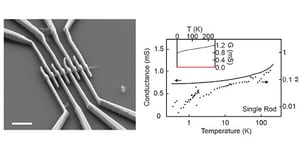 Crystalline, electrically conductive, and intrinsically porous materials are rare. Layered two-dimensional (2D) metal–organic frameworks (MOFs) break this trend. They are porous crystals that exhibit high electrical conductivity and are novel platforms for studying fundamentals of electricity and magnetism in two dimensions. Despite demonstrated applications, electrical transport in these remains poorly understood because of a lack of single crystal studies. Here, studies of single crystals of two 2D MOFs, Ni3(HITP)2 and Cu3(HHTP)2, uncover critical insights into their structure and transport. Conductivity measurements down to 0.3 K suggest metallicity for mesoscopic single crystals of Ni3(HITP)2, which contrasts with apparent activated conductivity for polycrystalline films. Microscopy studies further reveal that these MOFs are not isostructural as previously reported. Notably, single rods exhibit conductivities up to 150 S/cm, which persist even after prolonged exposure to ambient conditions. These single crystal studies confirm that 2D MOFs hold promise as molecularly tunable platforms for fundamental science and applications where porosity and conductivity are critical.
Crystalline, electrically conductive, and intrinsically porous materials are rare. Layered two-dimensional (2D) metal–organic frameworks (MOFs) break this trend. They are porous crystals that exhibit high electrical conductivity and are novel platforms for studying fundamentals of electricity and magnetism in two dimensions. Despite demonstrated applications, electrical transport in these remains poorly understood because of a lack of single crystal studies. Here, studies of single crystals of two 2D MOFs, Ni3(HITP)2 and Cu3(HHTP)2, uncover critical insights into their structure and transport. Conductivity measurements down to 0.3 K suggest metallicity for mesoscopic single crystals of Ni3(HITP)2, which contrasts with apparent activated conductivity for polycrystalline films. Microscopy studies further reveal that these MOFs are not isostructural as previously reported. Notably, single rods exhibit conductivities up to 150 S/cm, which persist even after prolonged exposure to ambient conditions. These single crystal studies confirm that 2D MOFs hold promise as molecularly tunable platforms for fundamental science and applications where porosity and conductivity are critical.
Metal–organic framework nanosheets for enhanced performance of organic photovoltaic cells
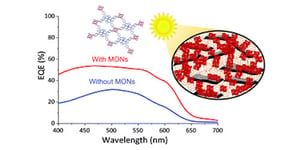 Metal–organic framework nanosheets (MONs) are an emerging class of two-dimensional materials whose diverse and readily tunable structures make them ideal for use in optoelectronic applications. Here, liquid exfoliation is used to synthesize ultrathin zinc-porphyrin based MONs with electronic and optical properties ideally suited for incorporation into a polythiophene–fullerene (P3HT–PCBM) organic solar cell. Remarkably, the addition of MONs to the photoactive layer of a photovoltaic device results in a power conversion efficiency of 5.2%, almost twice that for reference devices without nanosheets with a simultaneous improvement of Jsc, Voc and FF. Our analysis indicates that the complimentary electronic, optical and structural properties of the MONs allows them to act as a surface to template the crystallization of P3HT leading to a doubling of the absorbance, a tenfold increase in hole mobility and reduced grain size. These results demonstrate the potential of MONs as a tunable class of two-dimensional materials for enhancing the performance of a broad range of organic solar cells and other electronic devices.
Metal–organic framework nanosheets (MONs) are an emerging class of two-dimensional materials whose diverse and readily tunable structures make them ideal for use in optoelectronic applications. Here, liquid exfoliation is used to synthesize ultrathin zinc-porphyrin based MONs with electronic and optical properties ideally suited for incorporation into a polythiophene–fullerene (P3HT–PCBM) organic solar cell. Remarkably, the addition of MONs to the photoactive layer of a photovoltaic device results in a power conversion efficiency of 5.2%, almost twice that for reference devices without nanosheets with a simultaneous improvement of Jsc, Voc and FF. Our analysis indicates that the complimentary electronic, optical and structural properties of the MONs allows them to act as a surface to template the crystallization of P3HT leading to a doubling of the absorbance, a tenfold increase in hole mobility and reduced grain size. These results demonstrate the potential of MONs as a tunable class of two-dimensional materials for enhancing the performance of a broad range of organic solar cells and other electronic devices.
Gas Separation/Storage
High-Throughput Computational Screening of 12,351 Real Metal–Organic Framework Structures for Separation of Hexane Isomers: A Quest for a Yet Better Adsorbent
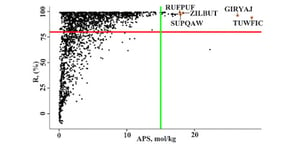 Adsorption-based separation of hexane isomers have been investigated widely by researchers across the globe employing variety of adsorbent materials including zeolites and metal–organic frameworks (MOFs). However, the quest for yet an efficient adsorbent is still of prime importance. In the present article, we have performed a high-throughput computational screening of 12,351 real MOF structures to identify the best candidate for separating the dibranched hexane isomers from their linear and monobranched counterparts. The screening strategy was based on both structural properties of the MOFs and other adsorptive separation performance metrics, namely, adsorption selectivity, working capacity, and regenerability (R%). The best candidate identified in the present screening investigation is MOF TUWFIC, which exhibits the highest adsorbent performance score (APS) of 28.46 mol/kg and regenerability of 94.09%. We ranked the top 10 MOFs having the highest APS values and with R% >80. In addition, we looked at various structure–property correlations in order to figure out ways to optimize the performance while designing new MOF structures. These correlations indicate that largest cavity diameter is the crucial structural property tuning, which can maximize the APS. One major concern about MOFs that researchers have been investigating is the stability of such structures at various conditions such as temperature, pressure, and chemical environment. We screened out few stable and potential candidate structures that have tetravalent metal cations and high APS and R% values. The MOF database adopted in the present investigation contains several MOFs having tetravalent metal cations such as Zr4+, Hf4+, and Ti4+, which perform remarkably well to separate the dibranched hexane isomers from their linear and monobranched counterparts at a temperature of 433 K. The top MOF consisting of tetravalent metal cation Zr4+ and exhibiting the highest APS value of 14.21 mol/kg is BOLZIN (NU-1100).
Adsorption-based separation of hexane isomers have been investigated widely by researchers across the globe employing variety of adsorbent materials including zeolites and metal–organic frameworks (MOFs). However, the quest for yet an efficient adsorbent is still of prime importance. In the present article, we have performed a high-throughput computational screening of 12,351 real MOF structures to identify the best candidate for separating the dibranched hexane isomers from their linear and monobranched counterparts. The screening strategy was based on both structural properties of the MOFs and other adsorptive separation performance metrics, namely, adsorption selectivity, working capacity, and regenerability (R%). The best candidate identified in the present screening investigation is MOF TUWFIC, which exhibits the highest adsorbent performance score (APS) of 28.46 mol/kg and regenerability of 94.09%. We ranked the top 10 MOFs having the highest APS values and with R% >80. In addition, we looked at various structure–property correlations in order to figure out ways to optimize the performance while designing new MOF structures. These correlations indicate that largest cavity diameter is the crucial structural property tuning, which can maximize the APS. One major concern about MOFs that researchers have been investigating is the stability of such structures at various conditions such as temperature, pressure, and chemical environment. We screened out few stable and potential candidate structures that have tetravalent metal cations and high APS and R% values. The MOF database adopted in the present investigation contains several MOFs having tetravalent metal cations such as Zr4+, Hf4+, and Ti4+, which perform remarkably well to separate the dibranched hexane isomers from their linear and monobranched counterparts at a temperature of 433 K. The top MOF consisting of tetravalent metal cation Zr4+ and exhibiting the highest APS value of 14.21 mol/kg is BOLZIN (NU-1100).Oxygen-Selective Adsorption Property of Ultramicroporous MOF Cu(Qc)2 for Air Separation
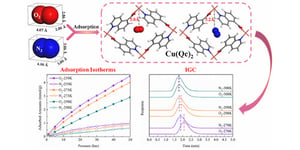 In this work, the O2/N2 adsorption behavior of ultramicroporous MOF Cu(Qc)2, with preferential adsorption of O2 over N2, was investigated for the first time. Cu(Qc)2 was prepared using a room-temperature synthesis strategy and then characterized. High-pressure isotherms of O2 and N2 were measured at different temperatures. The molecular simulation was used to reveal the adsorption mechanism of O2 and N2 on the copper sites of Cu(Qc)2. Inverse gas chromatography (IGC) experiments were applied to measure surface free energy for O2 and N2 adsorption for evaluation of the affinity between adsorbates O2/N2 and Cu(Qc)2. Results showed that the adsorbed amounts of O2 on Cu(Qc)2 increased significantly with pressure rising, reaching as high as 4.48 mmol/g at 259 K and 50 bar, while that of N2 increased slowly to 0.98 mmol/g. The uptake ratio of O2/N2 on Cu(Qc)2 reached 4.62 at 298 K and 50 bar. The IAST-predicted O2/N2 (21:78 v/v) selectivity of Cu(Qc)2 reached 7 at 259 K and 50 bar. The ultramicroporous MOF Cu(Qc)2 is the potential for separation of O2/N2 from the air.
In this work, the O2/N2 adsorption behavior of ultramicroporous MOF Cu(Qc)2, with preferential adsorption of O2 over N2, was investigated for the first time. Cu(Qc)2 was prepared using a room-temperature synthesis strategy and then characterized. High-pressure isotherms of O2 and N2 were measured at different temperatures. The molecular simulation was used to reveal the adsorption mechanism of O2 and N2 on the copper sites of Cu(Qc)2. Inverse gas chromatography (IGC) experiments were applied to measure surface free energy for O2 and N2 adsorption for evaluation of the affinity between adsorbates O2/N2 and Cu(Qc)2. Results showed that the adsorbed amounts of O2 on Cu(Qc)2 increased significantly with pressure rising, reaching as high as 4.48 mmol/g at 259 K and 50 bar, while that of N2 increased slowly to 0.98 mmol/g. The uptake ratio of O2/N2 on Cu(Qc)2 reached 4.62 at 298 K and 50 bar. The IAST-predicted O2/N2 (21:78 v/v) selectivity of Cu(Qc)2 reached 7 at 259 K and 50 bar. The ultramicroporous MOF Cu(Qc)2 is the potential for separation of O2/N2 from the air.Understanding How Ligand Functionalization Influences CO2 and N2 Adsorption in a Sodalite Metal–Organic Framework
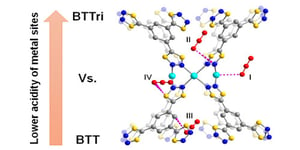 In this work, a detailed study is conducted to understand how ligand substitution influences the CO2 and N2 adsorption properties of two highly crystalline sodalite metal–organic frameworks (MOFs) known as Cu–BTT (BTT–3 = 1,3,5-benzenetristetrazolate) and Cu–BTTri (BTTri–3 = 1,3,5-benzenetristriazolate). The enthalpy of adsorption and observed adsorption capacities at a given pressure are significantly lower for Cu–BTTri compared to its tetrazole counterpart, Cu–BTT. In situ X-ray and neutron diffraction, which allow visualization of the CO2 and N2 binding sites on the internal surface of Cu–BTTri, provide insights into understanding the subtle differences. As expected, slightly elongated distances between the open Cu2+ sites and surface-bound CO2 in Cu–BTTri can be explained by the fact that the triazolate ligand is a better electron donor than the tetrazolate. The more pronounced Jahn–Teller effect in Cu–BTTri leads to weaker guest binding. The results of the aforementioned structural analysis were complemented by the prediction of the binding energies at each CO2 and N2 adsorption site by density functional theory calculations. In addition, variable temperature in situ diffraction measurements shed light on the fine structural changes of the framework and CO2 occupancies at different adsorption sites as a function of temperature. Finally, simulated breakthrough curves obtained for both sodalite MOFs demonstrate the materials’ potential performance in dry postcombustion CO2 capture. The simulation, which considers both framework uptake capacity and selectivity, predicts better separation performance for Cu–BTT. The information obtained in this work highlights how ligand substitution can influence adsorption properties and hence provides further insights into the material optimization for important separations.
In this work, a detailed study is conducted to understand how ligand substitution influences the CO2 and N2 adsorption properties of two highly crystalline sodalite metal–organic frameworks (MOFs) known as Cu–BTT (BTT–3 = 1,3,5-benzenetristetrazolate) and Cu–BTTri (BTTri–3 = 1,3,5-benzenetristriazolate). The enthalpy of adsorption and observed adsorption capacities at a given pressure are significantly lower for Cu–BTTri compared to its tetrazole counterpart, Cu–BTT. In situ X-ray and neutron diffraction, which allow visualization of the CO2 and N2 binding sites on the internal surface of Cu–BTTri, provide insights into understanding the subtle differences. As expected, slightly elongated distances between the open Cu2+ sites and surface-bound CO2 in Cu–BTTri can be explained by the fact that the triazolate ligand is a better electron donor than the tetrazolate. The more pronounced Jahn–Teller effect in Cu–BTTri leads to weaker guest binding. The results of the aforementioned structural analysis were complemented by the prediction of the binding energies at each CO2 and N2 adsorption site by density functional theory calculations. In addition, variable temperature in situ diffraction measurements shed light on the fine structural changes of the framework and CO2 occupancies at different adsorption sites as a function of temperature. Finally, simulated breakthrough curves obtained for both sodalite MOFs demonstrate the materials’ potential performance in dry postcombustion CO2 capture. The simulation, which considers both framework uptake capacity and selectivity, predicts better separation performance for Cu–BTT. The information obtained in this work highlights how ligand substitution can influence adsorption properties and hence provides further insights into the material optimization for important separations.
A microporous metal–organic framework with naphthalene diimide groups for high methane storage
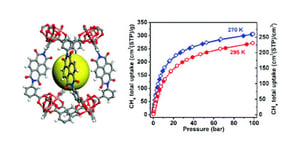 We reported a microporous MOF FJU-101 with open naphthalene diimide functional groups for room temperature (RT) high methane storage. At RT and 65 bar, the total volumetric CH4 storage capacity of 212 cm3 (STP) cm−3 of FJU-101a is significantly higher than those of the isoreticular MFM-130a and UTSA-40a. The enhanced methane uptake in FJU-101a is attributed to the polar carbonyl sites, which can generate strong electrostatic interactions with CH4 molecules.
We reported a microporous MOF FJU-101 with open naphthalene diimide functional groups for room temperature (RT) high methane storage. At RT and 65 bar, the total volumetric CH4 storage capacity of 212 cm3 (STP) cm−3 of FJU-101a is significantly higher than those of the isoreticular MFM-130a and UTSA-40a. The enhanced methane uptake in FJU-101a is attributed to the polar carbonyl sites, which can generate strong electrostatic interactions with CH4 molecules.
Calcium-Based Metal–Organic Framework for Simultaneous Capture of Trace Propyne and Propadiene from Propylene
 The simultaneous capture of trace propyne and propadiene from propylene is one of the important but energy demanding industrial processes because of their similar physicochemical properties as well as the ultralow concentration in the mixtures. Herein, a highly stable Ca-based MOF, constructed from an inexpensive precursor (CaCO3) and rigid squaric acid, is capable of preferentially capturing trace propyne and propadiene with record-high uptake capacities of 2.44 and 2.64 mmol/g at pressures as low as 5 mbar, respectively. Direct multicomponent breakthrough experiments confirm that Ca-based MOF exhibits an excellent performance for simultaneous removal of trace propyne and propadiene from propylene. DFT simulation and in situ single-crystal X-ray diffraction of propadiene- and propyne-adsorbed Ca-based MOFs reveal that the strong affinity of the framework toward two species is ascribed to the multiple types of cooperative binding including π–π stacking and C–H···O interactions. The calcium squarate framework sets a new benchmark for adsorptive purification of propylene, showing great potential in the practical application.
The simultaneous capture of trace propyne and propadiene from propylene is one of the important but energy demanding industrial processes because of their similar physicochemical properties as well as the ultralow concentration in the mixtures. Herein, a highly stable Ca-based MOF, constructed from an inexpensive precursor (CaCO3) and rigid squaric acid, is capable of preferentially capturing trace propyne and propadiene with record-high uptake capacities of 2.44 and 2.64 mmol/g at pressures as low as 5 mbar, respectively. Direct multicomponent breakthrough experiments confirm that Ca-based MOF exhibits an excellent performance for simultaneous removal of trace propyne and propadiene from propylene. DFT simulation and in situ single-crystal X-ray diffraction of propadiene- and propyne-adsorbed Ca-based MOFs reveal that the strong affinity of the framework toward two species is ascribed to the multiple types of cooperative binding including π–π stacking and C–H···O interactions. The calcium squarate framework sets a new benchmark for adsorptive purification of propylene, showing great potential in the practical application.
Toxic gas
Metal–Organic Frameworks against Toxic Chemicals
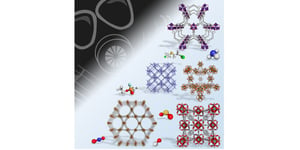 Materials capable of the safe and efficient capture or degradation of toxic chemicals, including chemical warfare agents (CWAs) and toxic industrial chemicals (TICs), are critically important in the modern age due to continuous threats of these chemicals to human life, both directly and indirectly. Metal–organic frameworks (MOFs), atomically precise hybrid materials that are synthesized via the self-assembly of metal cations or clusters and organic linkers, offer a unique solid adsorbent design platform due to their great synthetic versatility. This review will focus on recent advancements in MOF-based adsorbent design for protection against chemical warfare agents (organophosphorus nerve agents, blistering agents, and their simulants) and toxic industrial chemicals such as H2S, NH3, SO2, CO, NO2, and NO.
Materials capable of the safe and efficient capture or degradation of toxic chemicals, including chemical warfare agents (CWAs) and toxic industrial chemicals (TICs), are critically important in the modern age due to continuous threats of these chemicals to human life, both directly and indirectly. Metal–organic frameworks (MOFs), atomically precise hybrid materials that are synthesized via the self-assembly of metal cations or clusters and organic linkers, offer a unique solid adsorbent design platform due to their great synthetic versatility. This review will focus on recent advancements in MOF-based adsorbent design for protection against chemical warfare agents (organophosphorus nerve agents, blistering agents, and their simulants) and toxic industrial chemicals such as H2S, NH3, SO2, CO, NO2, and NO.
Cerium Oxide Nanoparticles Stabilized within Metal–Organic Frameworks for the Degradation of Nerve Agents
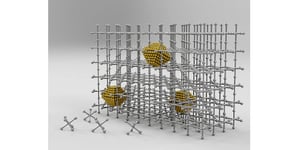 Ceria nanoparticles (CeNPs) are promising enzyme mimetic catalysts due to their mixed oxidation states Ce3+/Ce4+ accompanied by the presence of oxygen vacancies. While their properties have been widely recognized, control of their activity, modulation of the Ce3+/Ce4+ ratio, dispersity, and accessibility of the active sites continue to be a challenge. Herein, we report a technique to synthesize highly active, ultrasmall CeNPs dispersed within a cerium-based metal–organic framework (Ce-MOF) via in situ etching of the parent NPs. Etching and stabilization of CeNPs within the MOF significantly enhanced their activity, prevented aggregation, and provided high accessibility of the active sites for catalytic reactions through the open channels of the MOF. The resulting material showed an enhancement in the degradation kinetics of the nerve agent simulant dimethyl p-nitrophenylphosphate (DMNP) as compared to the parent CeNPs or the Ce-MOF. These properties, characterized by a combination of optical imaging and spectroscopic techniques, are due to increased oxygen vacancies, an enhanced Ce3+ content at the surface, and the formation of ultrasmall CeNPs (∼1–2 nm) highly dispersed within the MOF matrix. This technique offers a strategy for controlling the surface chemistry of CeNPs, making them significantly more active for use in catalysis, sensing, and environmental remediation.
Ceria nanoparticles (CeNPs) are promising enzyme mimetic catalysts due to their mixed oxidation states Ce3+/Ce4+ accompanied by the presence of oxygen vacancies. While their properties have been widely recognized, control of their activity, modulation of the Ce3+/Ce4+ ratio, dispersity, and accessibility of the active sites continue to be a challenge. Herein, we report a technique to synthesize highly active, ultrasmall CeNPs dispersed within a cerium-based metal–organic framework (Ce-MOF) via in situ etching of the parent NPs. Etching and stabilization of CeNPs within the MOF significantly enhanced their activity, prevented aggregation, and provided high accessibility of the active sites for catalytic reactions through the open channels of the MOF. The resulting material showed an enhancement in the degradation kinetics of the nerve agent simulant dimethyl p-nitrophenylphosphate (DMNP) as compared to the parent CeNPs or the Ce-MOF. These properties, characterized by a combination of optical imaging and spectroscopic techniques, are due to increased oxygen vacancies, an enhanced Ce3+ content at the surface, and the formation of ultrasmall CeNPs (∼1–2 nm) highly dispersed within the MOF matrix. This technique offers a strategy for controlling the surface chemistry of CeNPs, making them significantly more active for use in catalysis, sensing, and environmental remediation.
Water purification and environmental applications
Seawater Desalination Using MOF-Incorporated Cu-Based Alginate Beads without Energy Consumption
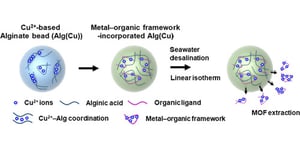 The demand for fresh water is gradually and globally increasing due to the growth of population and water contamination. To meet this global demand, we fabricated metal–organic framework (MOF)-incorporated Cu-based alginate beads (Cu–MOF–Alg beads) for effective removal of water-dissolved salt ions from seawater. Alginic acid formed a matrix for preconfined Cu coordination. In this matrix, the MOFs were successfully in situ synthesized with organic ligands. The as-prepared Cu–MOF–Alg beads exhibited exceptional salt ion adsorption with the extraction of sedimented MOF particles. The adsorption characteristics of the fabricated Cu–MOF–Alg beads exhibited a linear isotherm according to the concentration of Na+ ions. In addition, the beads could be applied over a wide concentration range of target solutions and maintained their ion adsorption capacity after three repeated uses. The beads exhibited rapid adsorption kinetics, and their salt ion removal rate was approximately 94.3% through a multistage adsorption process. The MOF-treated seawater, which was desalinated to a low concentration of 1000 ppm, was filtered by a mangrove-inspired membrane, which yielded a total ion removal rate of 98.1%. Considering the low material cost compared to other adsorption-based desalination techniques and the absence of external energy supply, the proposed hybrid desalination system can produce purified water at an extremely low cost. Thus, this desalination technique could be economically and ecofriendly utilized for practical seawater desalination in a facile manner.
The demand for fresh water is gradually and globally increasing due to the growth of population and water contamination. To meet this global demand, we fabricated metal–organic framework (MOF)-incorporated Cu-based alginate beads (Cu–MOF–Alg beads) for effective removal of water-dissolved salt ions from seawater. Alginic acid formed a matrix for preconfined Cu coordination. In this matrix, the MOFs were successfully in situ synthesized with organic ligands. The as-prepared Cu–MOF–Alg beads exhibited exceptional salt ion adsorption with the extraction of sedimented MOF particles. The adsorption characteristics of the fabricated Cu–MOF–Alg beads exhibited a linear isotherm according to the concentration of Na+ ions. In addition, the beads could be applied over a wide concentration range of target solutions and maintained their ion adsorption capacity after three repeated uses. The beads exhibited rapid adsorption kinetics, and their salt ion removal rate was approximately 94.3% through a multistage adsorption process. The MOF-treated seawater, which was desalinated to a low concentration of 1000 ppm, was filtered by a mangrove-inspired membrane, which yielded a total ion removal rate of 98.1%. Considering the low material cost compared to other adsorption-based desalination techniques and the absence of external energy supply, the proposed hybrid desalination system can produce purified water at an extremely low cost. Thus, this desalination technique could be economically and ecofriendly utilized for practical seawater desalination in a facile manner.
PCN-222 Metal–Organic Framework Nanoparticles with Tunable Pore Size for Nanocomposite Reverse Osmosis Membranes
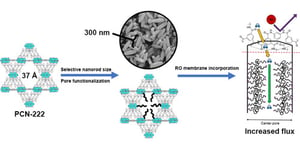 Nanorods of PCN-222, a large-pore, zirconium-based porphyrinic metal–organic framework (MOF), have been prepared through coordination modulation—controlled crystal growth through competing monodentate ligands known as modulators—for incorporation into reverse osmosis thin-film nanocomposite (TFN) membranes. Postsynthetic modification of the MOF node through binding of myristic acid (MA) altered channel dimensions and pore size distribution. The extent of MOF modification was characterized through Brunauer–Emmett–Teller gas sorption and 1H NMR following digestion of the particles. TFN membranes containing PCN-222 nanoparticles modified with varying levels of MA were fabricated via dispersion in the aqueous phase during interfacial polymerization, and the resulting flux and rejection performance of each membrane were evaluated. Increased water flux was observed with increasing MA content in the PCN-222 nanorods. Up to 95% increase in water flux was observed for a TFN containing 0.01 wt % loading of PCN-222 nanorods with a 10:1 MA to linker ratio, while maintaining high salt rejection. The flux change was attributed to tunable water transport through the nanorod pore structure and also through rapid water transport pathways at the nanorod–polymer interface.
Nanorods of PCN-222, a large-pore, zirconium-based porphyrinic metal–organic framework (MOF), have been prepared through coordination modulation—controlled crystal growth through competing monodentate ligands known as modulators—for incorporation into reverse osmosis thin-film nanocomposite (TFN) membranes. Postsynthetic modification of the MOF node through binding of myristic acid (MA) altered channel dimensions and pore size distribution. The extent of MOF modification was characterized through Brunauer–Emmett–Teller gas sorption and 1H NMR following digestion of the particles. TFN membranes containing PCN-222 nanoparticles modified with varying levels of MA were fabricated via dispersion in the aqueous phase during interfacial polymerization, and the resulting flux and rejection performance of each membrane were evaluated. Increased water flux was observed with increasing MA content in the PCN-222 nanorods. Up to 95% increase in water flux was observed for a TFN containing 0.01 wt % loading of PCN-222 nanorods with a 10:1 MA to linker ratio, while maintaining high salt rejection. The flux change was attributed to tunable water transport through the nanorod pore structure and also through rapid water transport pathways at the nanorod–polymer interface.
Magnetic metal–organic framework composites for environmental monitoring and remediation
 Environmental pollution remains one of the topical issues confronting scientist in the 21st century. The deployment of appropriate technology is among the promising routes of curbing the anthropogenic menace. Magnetic metal–organic framework (MMOF) composites, a combination of metal–organic frameworks and magnetic metal nanoparticles, results in the formation of composite materials with outstanding synergy properties that have been harnessed in several studies for environmental mitigation.
Environmental pollution remains one of the topical issues confronting scientist in the 21st century. The deployment of appropriate technology is among the promising routes of curbing the anthropogenic menace. Magnetic metal–organic framework (MMOF) composites, a combination of metal–organic frameworks and magnetic metal nanoparticles, results in the formation of composite materials with outstanding synergy properties that have been harnessed in several studies for environmental mitigation.
In this review, the detrimental effects of pollution on man and the environment are brought to the fore. The general methods for synthesizing MMOF composites and the classification of MMOF composites based on their composition with appropriate examples are highlighted. In-depth analysis of physicochemical properties of MMOF composites that are harnessed for the detection and remediation of environmental contaminants and are discussed. Furthermore, the practical applications of these auspicious composites to detect some environmental pollutants and remediate their effects on the environment are extensively explored. Finally, the new frontiers and prospects of MMOF composites in global environmental pollution mitigation is presented.
Pharmaceuticals
Ultrasensitive Fluorescent miRNA Biosensor Based on a “Sandwich” Oligonucleotide Hybridization and Fluorescence Resonance Energy Transfer Process Using an Ln(III)-MOF and Ag Nanoparticles for Early Cancer Diagnosis: Application of Central Composite Design
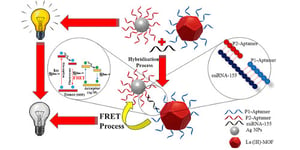 Herein, a novel, rapid, highly sensitive, and selective fluorescent biosensor is presented, which is designed based on “sandwich-type” hybridization of oligonucleotides and the fluorescence resonance energy transfer (FRET) strategy. It senses and determines the MicroRNA-155 (miRNA-155) expression levels as a cancer biomarker. In this study, a modified La(III)-metal–organic framework(MOF) and silver nanoparticles (Ag NPs) were used as the energy donor–acceptor pairs in fluorescence quenching through the FRET process. La(III)-MOF was synthesized and then modified by glutaraldehyde as a cross-linking agent. The Ag NPs were also prepared, and then, the surface of both was conjugated with different 5′-amino-labeled ssDNA strands (aptamers). These prepared nanoprobes were characterized by various physicochemical techniques such as X-ray diffraction, energy-dispersive X-ray spectrometry, Fourier transform infrared, field emission scanning electron microscopy, UV–vis spectroscopy, elemental mapping, and gel electrophoresis. To optimize the detection conditions, several factors affecting biosensor performance were assessed by one variable-at-a-time and central composite design methods. Under optimum conditions, this “turn-off” fluorescent biosensor could detect and determine as low as 0.04 ppb (ng. mL–1) or 5.5 fM of the miRNA-155 biomarker. Therefore, this biosensor provides highly promising potential for lung and breast cancer diagnosis.
Herein, a novel, rapid, highly sensitive, and selective fluorescent biosensor is presented, which is designed based on “sandwich-type” hybridization of oligonucleotides and the fluorescence resonance energy transfer (FRET) strategy. It senses and determines the MicroRNA-155 (miRNA-155) expression levels as a cancer biomarker. In this study, a modified La(III)-metal–organic framework(MOF) and silver nanoparticles (Ag NPs) were used as the energy donor–acceptor pairs in fluorescence quenching through the FRET process. La(III)-MOF was synthesized and then modified by glutaraldehyde as a cross-linking agent. The Ag NPs were also prepared, and then, the surface of both was conjugated with different 5′-amino-labeled ssDNA strands (aptamers). These prepared nanoprobes were characterized by various physicochemical techniques such as X-ray diffraction, energy-dispersive X-ray spectrometry, Fourier transform infrared, field emission scanning electron microscopy, UV–vis spectroscopy, elemental mapping, and gel electrophoresis. To optimize the detection conditions, several factors affecting biosensor performance were assessed by one variable-at-a-time and central composite design methods. Under optimum conditions, this “turn-off” fluorescent biosensor could detect and determine as low as 0.04 ppb (ng. mL–1) or 5.5 fM of the miRNA-155 biomarker. Therefore, this biosensor provides highly promising potential for lung and breast cancer diagnosis.
Multivariate Modulation of the Zr MOF UiO‐66 for Defect‐Controlled Combination Anticancer Drug Delivery
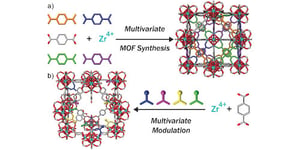 Metal–organic frameworks (MOFs) are emerging as leading candidates for nanoscale drug delivery, as a consequence of their high drug capacities, ease of functionality, and the ability to carefully engineer key physical properties. Despite many anticancer treatment regimens consisting of a cocktail of different drugs, examples of delivery of multiple drugs from one MOF are rare, potentially hampered by difficulties in postsynthetic loading of more than one cargo molecule. Herein, we report a new strategy, multivariate modulation, which allows incorporation of up to three drugs in the Zr MOF UiO‐66 by defect‐loading. The drugs are added to one‐pot solvothermal synthesis and are distributed throughout the MOF at defect sites by coordination to the metal clusters. This tight binding comes with retention of crystallinity and porosity, allowing a fourth drug to be postsynthetically loaded into the MOFs to yield nanoparticles loaded with cocktails of drugs that show enhancements in selective anticancer cytotoxicity against MCF‐7 breast cancer cells in vitro. We believe that multivariate modulation is a significant advance in the application of MOFs in biomedicine, and anticipate the protocol will also be adopted in other areas of MOF chemistry, to easily produce defective MOFs with arrays of highly functionalised pores for potential application in gas separations and catalysis.
Metal–organic frameworks (MOFs) are emerging as leading candidates for nanoscale drug delivery, as a consequence of their high drug capacities, ease of functionality, and the ability to carefully engineer key physical properties. Despite many anticancer treatment regimens consisting of a cocktail of different drugs, examples of delivery of multiple drugs from one MOF are rare, potentially hampered by difficulties in postsynthetic loading of more than one cargo molecule. Herein, we report a new strategy, multivariate modulation, which allows incorporation of up to three drugs in the Zr MOF UiO‐66 by defect‐loading. The drugs are added to one‐pot solvothermal synthesis and are distributed throughout the MOF at defect sites by coordination to the metal clusters. This tight binding comes with retention of crystallinity and porosity, allowing a fourth drug to be postsynthetically loaded into the MOFs to yield nanoparticles loaded with cocktails of drugs that show enhancements in selective anticancer cytotoxicity against MCF‐7 breast cancer cells in vitro. We believe that multivariate modulation is a significant advance in the application of MOFs in biomedicine, and anticipate the protocol will also be adopted in other areas of MOF chemistry, to easily produce defective MOFs with arrays of highly functionalised pores for potential application in gas separations and catalysis.
Design of a functionalized metal-organic framework system for enhanced targeted delivery to mitochondria
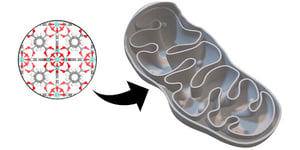 Mitochondria play a key role in oncogenesis and constitute one of the most important targets for cancer treatments. Although the most effective way to deliver drugs to mitochondria is by covalently linking them to a lipophilic cation, the in vivo delivery of free drugs still constitutes a critical bottleneck. Herein, we report the design of a mitochondria-targeted metal–organic framework (MOF) that greatly increases the efficacy of a model cancer drug, reducing the required dose to less than 1% compared to the free drug and ca. 10% compared to the nontargeted MOF. The performance of the system is evaluated using a holistic approach ranging from microscopy to transcriptomics. Super-resolution microscopy of MCF-7 cells treated with the targeted MOF system reveals important mitochondrial morphology changes that are clearly associated with cell death as soon as 30 min after incubation. Whole transcriptome analysis of cells indicates widespread changes in gene expression when treated with the MOF system, specifically in biological processes that have a profound effect on cell physiology and that are related to cell death. We show how targeting MOFs toward mitochondria represents a valuable strategy for the development of new drug delivery systems.
Mitochondria play a key role in oncogenesis and constitute one of the most important targets for cancer treatments. Although the most effective way to deliver drugs to mitochondria is by covalently linking them to a lipophilic cation, the in vivo delivery of free drugs still constitutes a critical bottleneck. Herein, we report the design of a mitochondria-targeted metal–organic framework (MOF) that greatly increases the efficacy of a model cancer drug, reducing the required dose to less than 1% compared to the free drug and ca. 10% compared to the nontargeted MOF. The performance of the system is evaluated using a holistic approach ranging from microscopy to transcriptomics. Super-resolution microscopy of MCF-7 cells treated with the targeted MOF system reveals important mitochondrial morphology changes that are clearly associated with cell death as soon as 30 min after incubation. Whole transcriptome analysis of cells indicates widespread changes in gene expression when treated with the MOF system, specifically in biological processes that have a profound effect on cell physiology and that are related to cell death. We show how targeting MOFs toward mitochondria represents a valuable strategy for the development of new drug delivery systems.
Fabricating Covalent Organic Framework Capsules with Commodious Microenvironment for Enzymes
 Enzyme immobilization has been demonstrated to be a favorable protocol to promote industrialization of biomacromolecules. Despite tremendous efforts to develop new strategies and materials to realize this process, maintaining enzyme activity is still a formidable challenge. Herein we created a sacrificial templating method, using metal–organic frameworks (MOFs) as sacrificial templates to construct hollow covalent organic framework (COF) capsules for enzyme encapsulation. This strategy can provide a capacious microenvironment to unleash enzyme molecules. The improved conformational freedom of enzymes, enhanced mass transfer, and protective effect against the external environment ultimately boosted the enzymatic activities. We also found that this strategy possesses high versatility that is suitable for diverse biomacromolecules, MOF templates, and COF capsules. Moreover, the dimensions, pore sizes, and shell thickness of COF capsules can be conveniently tuned, allowing for customizing bioreactors for specific functions. For example, coencapsulation of different enzymes with synergistic functions were successfully demonstrated using this bioreactor platform. This study not only opens up a new avenue to overcome the present limitations of enzymatic immobilization in porous matrixes but also provides new opportunities for construction of biomicrodevices or artificial organelles based on crystalline porous materials.
Enzyme immobilization has been demonstrated to be a favorable protocol to promote industrialization of biomacromolecules. Despite tremendous efforts to develop new strategies and materials to realize this process, maintaining enzyme activity is still a formidable challenge. Herein we created a sacrificial templating method, using metal–organic frameworks (MOFs) as sacrificial templates to construct hollow covalent organic framework (COF) capsules for enzyme encapsulation. This strategy can provide a capacious microenvironment to unleash enzyme molecules. The improved conformational freedom of enzymes, enhanced mass transfer, and protective effect against the external environment ultimately boosted the enzymatic activities. We also found that this strategy possesses high versatility that is suitable for diverse biomacromolecules, MOF templates, and COF capsules. Moreover, the dimensions, pore sizes, and shell thickness of COF capsules can be conveniently tuned, allowing for customizing bioreactors for specific functions. For example, coencapsulation of different enzymes with synergistic functions were successfully demonstrated using this bioreactor platform. This study not only opens up a new avenue to overcome the present limitations of enzymatic immobilization in porous matrixes but also provides new opportunities for construction of biomicrodevices or artificial organelles based on crystalline porous materials.
Catalysis
Confined Catalysts Inside CNTs Derived from 2D Metal-Organic Framework for Electrolysis
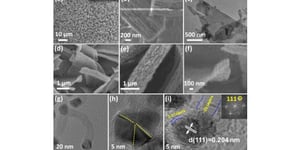 Two-dimensional metal-organic framework (MOF) nanosheets have attracted considerable research interests as electrocatalysts, and thermal annealing is important to boost their conductivity. The effect of annealing atmosphere on the electrochemical performance of 2D MOF and their catalytic center structure have been investigated. Co-MOF/H2 synthesized by annealing of 2D MOF in H2 has shown significantly enhanced catalytic activity compared with those annealed in Ar atmosphere (Co-MOF/Ar). Co-MOF/H2 has 2-3 graphitic layers of graphitic carbon coating and presents a large amount of high valence Co2+. H2 annealing leads to a fast reduction of Co-MOF to Co/CoOx nanoparticles and catalyzes the CNTs growth from its carbon source. Co-MOF/H2 has a high electrocatalytic activity which required an overpotential of 312 mV to reach a current density of 10 mA cm-2. Co-MOF/H2-based water electrolyzer only required a potential of 1.619 V to reach a current density of 10 mA cm-2 for overall waters splitting in 1.0 M KOH. After 25h of continuous operation for water electrolysis, Co-MOF/H2-based cell has shown a negligible increase of overpotential, indicating its superior durability than 2D Co-MOF.
Two-dimensional metal-organic framework (MOF) nanosheets have attracted considerable research interests as electrocatalysts, and thermal annealing is important to boost their conductivity. The effect of annealing atmosphere on the electrochemical performance of 2D MOF and their catalytic center structure have been investigated. Co-MOF/H2 synthesized by annealing of 2D MOF in H2 has shown significantly enhanced catalytic activity compared with those annealed in Ar atmosphere (Co-MOF/Ar). Co-MOF/H2 has 2-3 graphitic layers of graphitic carbon coating and presents a large amount of high valence Co2+. H2 annealing leads to a fast reduction of Co-MOF to Co/CoOx nanoparticles and catalyzes the CNTs growth from its carbon source. Co-MOF/H2 has a high electrocatalytic activity which required an overpotential of 312 mV to reach a current density of 10 mA cm-2. Co-MOF/H2-based water electrolyzer only required a potential of 1.619 V to reach a current density of 10 mA cm-2 for overall waters splitting in 1.0 M KOH. After 25h of continuous operation for water electrolysis, Co-MOF/H2-based cell has shown a negligible increase of overpotential, indicating its superior durability than 2D Co-MOF.
Cu-BTC metal-organic framework (MOF) as an efficient heterogeneous catalyst for aerobic oxidative synthesis of imines from primary amines under solvent free conditions
A Cu-BTC (MOF-199) [copper(II)-benzene-1,3,5-tricarboxylate] catalyst has been synthesized and evaluated for imine synthesis from amine compounds under neat conditions. The performance of the Cu-BTC MOF was significantly higher than that of the CuO supported on Al2O3, TiO2 and SiO2 catalysts. The role of surface Lewis acid sites on the catalyst in the formation of imine products was illustrated by the pyridine-IR studies. The recovered Cu-BTC catalyst demonstrated consistent activity for five cycles under similar experimental conditions. The physicochemical properties of the catalysts were analyzed by XRD, BET-SA, FT-IR, UV-DRS, SEM, TEM, XPS and pyridine adsorbed DRIFT spectroscopy.
Synthesis and Characterization of Ultrapure HKUST‐1 MOFs as Reusable Heterogeneous Catalysts for the Green Synthesis of Tetrazole Derivatives
 Herein, an ultrapure HKUST‐1 MOFs synthesized through a precise methodology as a heterogeneous catalyst for a green approach to the synthesis of tetrazole derivatives via two‐, three‐, and four‐component reactions in milder reaction conditions, is presented. Various preparation methods to produce HKUST‐1 such as microwave irradiation, reflux, hydrothermal technique, and ultrasonication have been precisely compared and it has been proven that the best result is obtained during the hydrothermal technique. This is the first design, preparation, characterization, and application in the present of HKUST‐1 MOFs to the synthesis of the biologically and pharmaceutically important tetrazole compounds in green conditions. Moreover, plausible mechanisms of reactions have also been suggested for the catalytic activity of the presented catalyst. The catalyst was characterized by various techniques such as FT‐IR, SEM, EDX, and XRD. Additionally, HKUST‐1 is recoverable as well as reusable without any significant loss of its activity, which strongly supports the heterogeneous nature of the catalyyst. This novel catalysis protocol offers several advantages such as eco‐friendly conditions, lower reaction time, milder reaction conditions, excellent catalytic activity and an easy separation of the catalyst make it a good heterogeneous system.
Herein, an ultrapure HKUST‐1 MOFs synthesized through a precise methodology as a heterogeneous catalyst for a green approach to the synthesis of tetrazole derivatives via two‐, three‐, and four‐component reactions in milder reaction conditions, is presented. Various preparation methods to produce HKUST‐1 such as microwave irradiation, reflux, hydrothermal technique, and ultrasonication have been precisely compared and it has been proven that the best result is obtained during the hydrothermal technique. This is the first design, preparation, characterization, and application in the present of HKUST‐1 MOFs to the synthesis of the biologically and pharmaceutically important tetrazole compounds in green conditions. Moreover, plausible mechanisms of reactions have also been suggested for the catalytic activity of the presented catalyst. The catalyst was characterized by various techniques such as FT‐IR, SEM, EDX, and XRD. Additionally, HKUST‐1 is recoverable as well as reusable without any significant loss of its activity, which strongly supports the heterogeneous nature of the catalyyst. This novel catalysis protocol offers several advantages such as eco‐friendly conditions, lower reaction time, milder reaction conditions, excellent catalytic activity and an easy separation of the catalyst make it a good heterogeneous system.
Basic Research
Investigating the Melting Behaviour of Polymorphic Zeolitic Imidazolate Frameworks
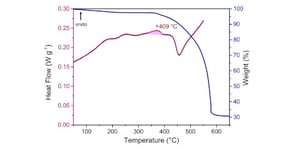 Recently, there has been growing interest in the amorphous states of metal–organic frameworks (MOFs). Particular focus has been given to melt-quenched MOF glasses. In this work, to improve our understanding of the factors influencing melting, the thermal response of four closely related zeolitic imidazolate frameworks (ZIFs) was studied. Electron withdrawing ligands were found to lower both the melting and glass transition temperatures, providing a promising strategy for improving the processability of MOFs in the liquid state. Crucially, dense frameworks appear to be essential for melting, with their presence also initiating the melting of open pore frameworks. This opens up the rich polymorphic landscape of ZIFs to the preparation of novel MOF liquids and glasses.
Recently, there has been growing interest in the amorphous states of metal–organic frameworks (MOFs). Particular focus has been given to melt-quenched MOF glasses. In this work, to improve our understanding of the factors influencing melting, the thermal response of four closely related zeolitic imidazolate frameworks (ZIFs) was studied. Electron withdrawing ligands were found to lower both the melting and glass transition temperatures, providing a promising strategy for improving the processability of MOFs in the liquid state. Crucially, dense frameworks appear to be essential for melting, with their presence also initiating the melting of open pore frameworks. This opens up the rich polymorphic landscape of ZIFs to the preparation of novel MOF liquids and glasses.
Mitigation of Pressure-Induced Amorphization in Metal–Organic Framework ZIF-8 upon EPR Control
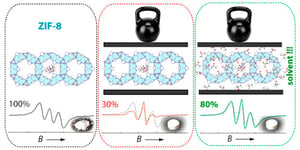 Pressure-induced amorphization is one of the processes inhibiting functional properties of metal–organic frameworks (MOFs). Such amorphization often occurs when MOFs are being shaped for practical applications, as well as during certain exploitations. Typically, the porosity of MOFs, which is crucial for sorption, separation, and catalysis, suffers under external pressure. We report a new experimental approach for efficient monitoring of pressure-induced processes in MOFs that employs trace amounts of spin probes (stable nitroxide radicals) embedded in the pores of MOF and detection by electron paramagnetic resonance (EPR). EPR spectra of spin probes in MOF ZIF-8 demonstrate significant changes upon pressure-induced amorphization, whose extent can be quantitatively determined from the spectral shapes. Moreover, stabilization of ZIF-8 against amorphization via reversible adsorption of various guests was studied using this approach. Mitigation effect depends on diffusion parameters and localization of guest molecules in the cavity, and maintaining of the structure and permeability up to 80% was achieved even at 1.15 GPa applied. Therefore, the proposed methodology allows significant mitigation of MOF amorphization under external pressure and conveys further perspectives of the controlled adjustment of stabilizing agents for various MOFs and their applications.
Pressure-induced amorphization is one of the processes inhibiting functional properties of metal–organic frameworks (MOFs). Such amorphization often occurs when MOFs are being shaped for practical applications, as well as during certain exploitations. Typically, the porosity of MOFs, which is crucial for sorption, separation, and catalysis, suffers under external pressure. We report a new experimental approach for efficient monitoring of pressure-induced processes in MOFs that employs trace amounts of spin probes (stable nitroxide radicals) embedded in the pores of MOF and detection by electron paramagnetic resonance (EPR). EPR spectra of spin probes in MOF ZIF-8 demonstrate significant changes upon pressure-induced amorphization, whose extent can be quantitatively determined from the spectral shapes. Moreover, stabilization of ZIF-8 against amorphization via reversible adsorption of various guests was studied using this approach. Mitigation effect depends on diffusion parameters and localization of guest molecules in the cavity, and maintaining of the structure and permeability up to 80% was achieved even at 1.15 GPa applied. Therefore, the proposed methodology allows significant mitigation of MOF amorphization under external pressure and conveys further perspectives of the controlled adjustment of stabilizing agents for various MOFs and their applications.
These were the most interesting papers / news we read in the last quarter. If you have suggestions or feedback, don’t hesitate to leave a comment!







